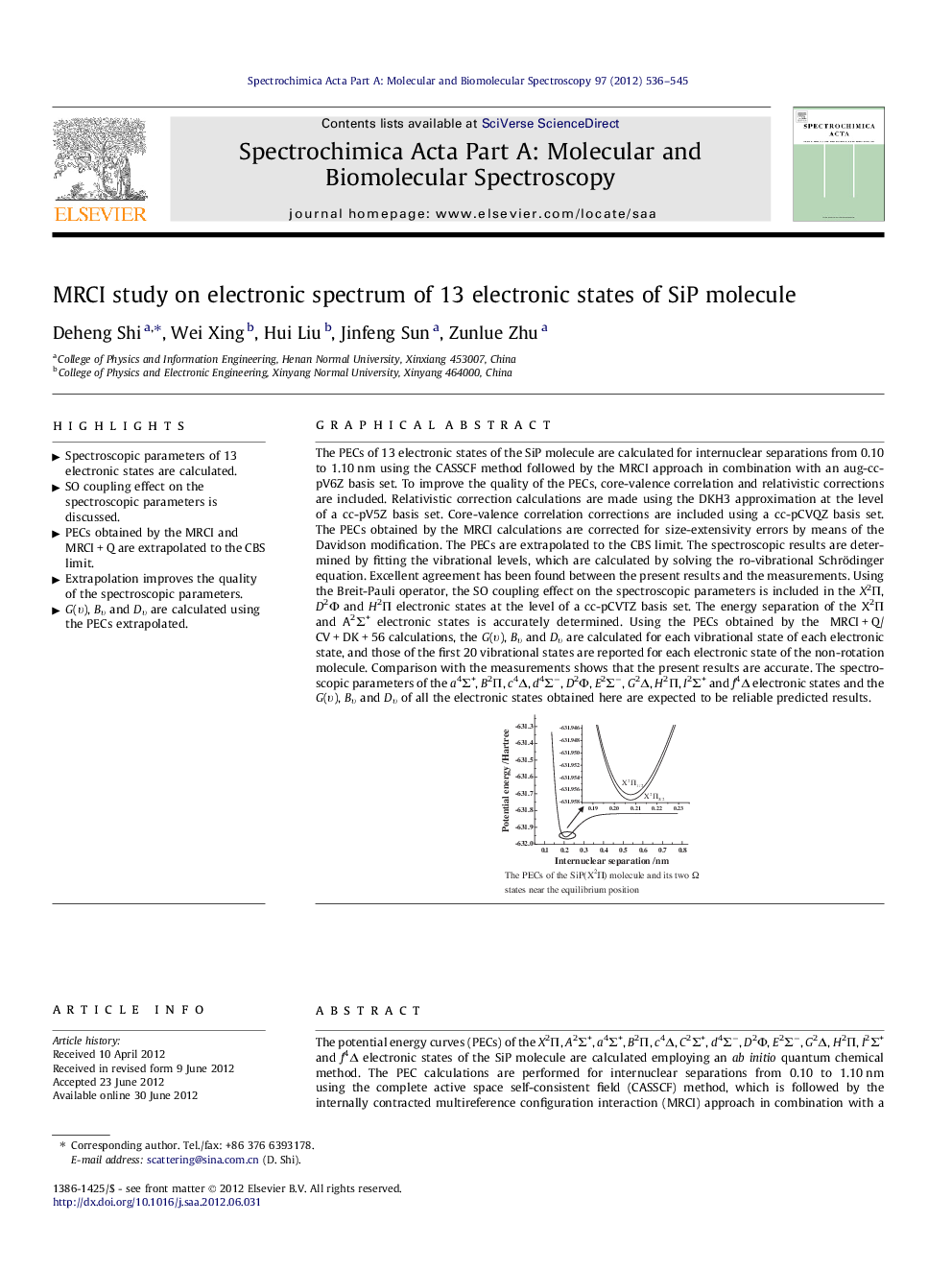| Article ID | Journal | Published Year | Pages | File Type |
|---|---|---|---|---|
| 1232344 | Spectrochimica Acta Part A: Molecular and Biomolecular Spectroscopy | 2012 | 10 Pages |
The potential energy curves (PECs) of the X2Π, A2Σ+, a4Σ+, B2Π, c4Δ, C2Σ+, d4Σ−, D2Φ, E2Σ−, G2Δ, H2Π, I2Σ+ and f4Δ electronic states of the SiP molecule are calculated employing an ab initio quantum chemical method. The PEC calculations are performed for internuclear separations from 0.10 to 1.10 nm using the complete active space self-consistent field (CASSCF) method, which is followed by the internally contracted multireference configuration interaction (MRCI) approach in combination with a correlation-consistent aug-cc-pV6Z basis set. To improve the quality of the PECs, core-valence correlation and scalar relativistic corrections are included. Scalar relativistic correction calculations are carried out using the third-order Douglas-Kroll Hamiltonian approximation at the level of a cc-pV5Z basis set. Core-valence correlation corrections are included using a cc-pCVQZ basis set. The PECs obtained by the MRCI calculations are corrected for size-extensivity errors by means of the Davidson modification. The PECs are extrapolated to the complete basis set limit. The spectroscopic parameters are obtained by fitting the vibrational levels, which are calculated by solving the ro-vibrational Schrödinger equation. The spectroscopic results are compared in detail with those reported in previous literature. Excellent agreement is found between the present spectroscopic results and the experimental ones. Using the Breit-Pauli operator, the spin–orbit (SO) coupling effect on the spectroscopic parameters is included in the X2Π, D2Φ and H2Π electronic states at the level of a cc-pCVTZ basis set. The energy separation of the X2Π and A2Σ+ electronic states is accurately determined by including the Davidson modification, SO coupling and core-valence correlation and scalar relativistic corrections. Using the PECs determined by the MRCI + Q/CV + DK + 56 calculations, the G(υ), Bυ and Dυ are calculated for each vibrational state of each electronic state, and those of the first 20 vibrational states are reported for each electronic state of the non-rotation 29Si31P molecule. Comparison with the measurements demonstrates that the present results are accurate. The spectroscopic parameters of the a4Σ+, B2Π, c4Δ, d4Σ−, D2Φ, E2Σ−, G2Δ, H2Π, I2Σ+ and f4Δ electronic states and the G(υ), Bυ and Dυ of all the electronic states obtained here are expected to be reliable predicted results.
Graphical abstractThe PECs of 13 electronic states of the SiP molecule are calculated for internuclear separations from 0.10 to 1.10 nm using the CASSCF method followed by the MRCI approach in combination with an aug-cc-pV6Z basis set. To improve the quality of the PECs, core-valence correlation and relativistic corrections are included. Relativistic correction calculations are made using the DKH3 approximation at the level of a cc-pV5Z basis set. Core-valence correlation corrections are included using a cc-pCVQZ basis set. The PECs obtained by the MRCI calculations are corrected for size-extensivity errors by means of the Davidson modification. The PECs are extrapolated to the CBS limit. The spectroscopic results are determined by fitting the vibrational levels, which are calculated by solving the ro-vibrational Schrödinger equation. Excellent agreement has been found between the present results and the measurements. Using the Breit-Pauli operator, the SO coupling effect on the spectroscopic parameters is included in the X2Π, D2Φ and H2Π electronic states at the level of a cc-pCVTZ basis set. The energy separation of the X2Π and A2Σ+ electronic states is accurately determined. Using the PECs obtained by the MRCI + Q/CV + DK + 56 calculations, the G(υ), Bυ and Dυ are calculated for each vibrational state of each electronic state, and those of the first 20 vibrational states are reported for each electronic state of the non-rotation molecule. Comparison with the measurements shows that the present results are accurate. The spectroscopic parameters of the a4Σ+, B2Π, c4Δ, d4Σ−, D2Φ, E2Σ−, G2Δ, H2Π, I2Σ+ and f4Δ electronic states and the G(υ), Bυ and Dυ of all the electronic states obtained here are expected to be reliable predicted results.Figure optionsDownload full-size imageDownload as PowerPoint slideHighlights► Spectroscopic parameters of 13 electronic states are calculated. ► SO coupling effect on the spectroscopic parameters is discussed. ► PECs obtained by the MRCI and MRCI + Q are extrapolated to the CBS limit. ► Extrapolation improves the quality of the spectroscopic parameters. ► G(υ), Bυ and Dυ are calculated using the PECs extrapolated.
